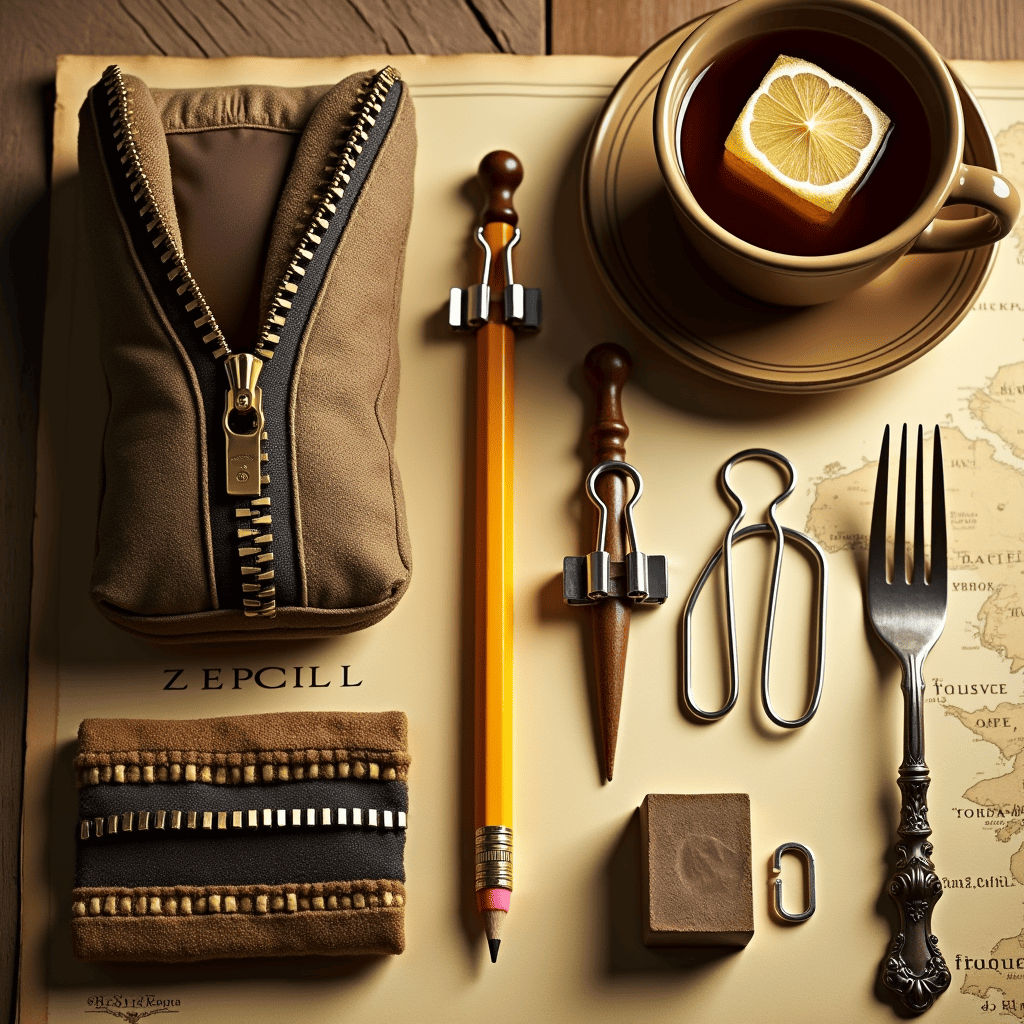What If Everyday Objects Could Speak?
What if the objects we use every day—coins jingling in our pockets, pottery displayed on our shelves, or even the names of the streets we walk—could whisper stories from centuries ago? Imagine holding a coin minted during the reign of an ancient emperor, or using a piece of pottery crafted by hands long turned to dust. These everyday items are more than just functional; they are silent witnesses to the lives, cultures, and events that shaped our world. They carry within them the echoes of history, waiting to be heard.
History Isn’t Just in Museums—It’s All Around Us
History is often thought of as something distant and abstract, confined to the pages of textbooks or the glass cases of museums. But the truth is, history is all around us, woven into the fabric of our daily lives. It’s in the streets we traverse, the tools we use, and the artifacts we often overlook. These ordinary objects are like time capsules, preserving the stories of the people who made them, used them, and passed them down through generations. They remind us that history isn’t just about grand events or famous figures—it’s also about the everyday lives of ordinary people, their struggles, triumphs, and traditions.
Exploring the Traces of History in Everyday Life
In this blog, we’ll embark on a journey to uncover the hidden histories of everyday objects. From ancient coins and pottery to the names of the streets we walk, we’ll explore how these seemingly mundane items carry traces of the past and connect us to civilizations long gone. By examining these objects, we’ll gain a deeper appreciation for the richness of human history and the ways it continues to shape our present. So, let’s take a closer look at the world around us and discover the stories that have been hiding in plain sight all along.

Section 1: Coins – Pocket-Sized Time Machines
More Than Just Currency
Coins are often seen as mere tools for trade, but they are far more than that—they are tiny, portable windows into the past. Each coin is a historical artifact, meticulously designed to reflect the values, beliefs, and priorities of the society that created it. From the materials used to the images and inscriptions stamped on their surfaces, coins tell stories of empires, economies, and everyday life. They are, in essence, pocket-sized time machines that allow us to travel back in time and glimpse the world as it once was.
Roman Coins: Power and Propaganda
Roman coins are a prime example of how currency was used as a tool of propaganda. Emperors like Augustus and Nero used coins to project their power and legitimacy. The faces of rulers were stamped onto coins, ensuring their image was seen far and wide, even in the most remote corners of the empire. Inscriptions often celebrated military victories or divine favor, reinforcing the emperor’s authority. For example, coins minted during the reign of Julius Caesar often featured his likeness alongside symbols of victory, such as laurel wreaths, to solidify his status as a triumphant leader.
Ancient Greek Coins: Gods and Goddesses
Ancient Greek coins, on the other hand, were deeply tied to religion and mythology. Cities like Athens and Corinth minted coins adorned with images of their patron deities—Athena, Apollo, or Poseidon—reflecting the spiritual beliefs of the people. These coins weren’t just currency; they were expressions of civic pride and religious devotion. The owl of Athena, for instance, became a symbol of Athenian identity and prosperity, appearing on coins that circulated across the Mediterranean.
Colonial-Era Coins: Trade and Conquest
Colonial-era coins tell stories of exploration, trade, and conquest. Spanish silver coins, known as “pieces of eight,” were minted in the Americas and became a global currency, facilitating trade between Europe, Asia, and the Americas. These coins often bore the crests of European monarchs, symbolizing their dominance over newly conquered territories. Similarly, British colonial coins in India and Africa often featured the image of the British monarch, serving as a reminder of imperial control.
Insights from Materials, Designs, and Inscriptions
The materials used to mint coins—whether gold, silver, or bronze—reveal the economic priorities and resources of a society. For example, the debasement of Roman silver coins over time reflects the empire’s economic decline. Designs and inscriptions provide clues about political alliances, cultural values, and even technological advancements. A coin is not just a piece of metal; it’s a snapshot of a moment in history, frozen in time.
Section 2: Pottery – Fragments of Daily Life
Treasure Troves for Archaeologists
Pottery is one of the most common artifacts found at archaeological sites, and for good reason. Unlike organic materials that decay over time, pottery is durable, often surviving for thousands of years. Even broken shards, known as sherds, can provide invaluable insights into the lives of ancient people. From the way pottery was made to the designs etched onto its surface, these fragments tell stories of daily life, trade, and cultural exchange.
Ancient Mesopotamian Pottery: The Birth of Writing
In ancient Mesopotamia, pottery played a crucial role in the development of writing. Early clay tablets, inscribed with cuneiform script, were used for record-keeping and communication. Pottery vessels from this region often bear inscriptions that document transactions, laws, or even literature, such as the Epic of Gilgamesh. These artifacts reveal how writing evolved from simple pictograms to a complex system of communication, laying the foundation for modern writing.
Native American Pottery: Nature and Spirituality
Native American pottery is a testament to the deep connection between indigenous cultures and the natural world. Tribes like the Pueblo and Navajo created pottery with intricate designs inspired by nature—geometric patterns, animal motifs, and symbols of the sun and moon. These designs were not just decorative; they held spiritual significance, reflecting the beliefs and traditions of the people who made them. Pottery was also used in rituals, such as storing sacred objects or preparing ceremonial foods.
Medieval European Pottery: Trade and Cultural Exchange
Medieval European pottery tells stories of trade and cultural exchange. For example, the intricate blue-and-white ceramics of the Islamic world influenced the development of European pottery during the Middle Ages. Pottery fragments found in Viking settlements reveal the extent of their trade networks, with items from as far away as the Middle East and North Africa. These artifacts show how pottery was not just a local craft but a global commodity, connecting distant cultures.
Styles, Materials, and Uses
The styles and materials of pottery vary widely across cultures and time periods, reflecting the resources and technologies available. For example, ancient Greek pottery was often painted with scenes from mythology, while Roman pottery was more utilitarian, designed for everyday use. Pottery also served a variety of purposes, from storing food and water to cooking and serving meals. In some cultures, pottery was used in burial rituals, with vessels placed in graves to accompany the deceased into the afterlife.
A Window into Daily Life
Pottery provides a unique glimpse into the daily lives of people in the past. The wear and tear on a cooking pot can tell us about the foods people ate, while the size and shape of storage jars reveal how they preserved their resources. Decorations and inscriptions offer clues about social status, religious beliefs, and artistic trends. In many ways, pottery is a mirror of society, reflecting the values, needs, and creativity of the people who made and used it.

Section 3: Street Names – Walking Through History
Commemorating History Through Street Names
Street names are more than just practical markers for navigation—they are cultural and historical signposts that tell the story of a place. From honoring revolutionary heroes to reflecting societal values, street names often commemorate significant events, figures, or ideals. They serve as a constant reminder of the past, shaping the identity of a city or town and connecting its present to its history.
Streets Named After Independence Heroes and Revolutionaries
Many streets around the world are named after individuals who fought for freedom and justice. For example, Martin Luther King Jr. Boulevard can be found in countless cities across the United States, honoring the civil rights leader’s legacy. Similarly, streets named after figures like Mahatma Gandhi in India or Simón Bolívar in South America celebrate their roles in independence movements. These names not only honor the individuals but also keep their struggles and achievements alive in public memory.
European Streets Reflecting Revolutionary Ideals
In Europe, street names often reflect the ideals of historical movements. After the French Revolution, many streets were renamed to celebrate liberty, equality, and fraternity. For instance, Rue de la Liberté (Street of Liberty) and Place de la République (Republic Square) became common, symbolizing the shift from monarchy to democracy. These names serve as enduring reminders of the revolutionary spirit that transformed societies.
Ancient Roman Roads: Engineering Marvels of the Past
Some streets have histories that stretch back thousands of years. The Appian Way in Rome, one of the earliest and most important Roman roads, is a prime example. Built in 312 BCE, it connected Rome to southern Italy and was a marvel of engineering. Today, parts of the Appian Way still exist, offering a tangible link to the Roman Empire’s infrastructure and ambition. Walking on such roads is like stepping into the footsteps of ancient travelers, soldiers, and traders.
The Darker Histories Behind Street Names
While many street names celebrate positive aspects of history, others reveal darker legacies. Streets named after colonial figures or events often reflect the erasure of indigenous cultures and histories. For example, in former colonies, streets named after European explorers or rulers can serve as painful reminders of exploitation and oppression. In recent years, there has been a growing movement to rename such streets to honor local heroes and reclaim cultural identity.
Section 4: Other Everyday Objects with Historical Traces
Books and Manuscripts: Personal Histories in the Margins
Books and manuscripts are more than just vessels for written words—they are historical artifacts that carry the marks of their readers. Marginal notes, doodles, and bookplates (personalized labels) reveal how people interacted with texts. For example, medieval manuscripts often contain annotations by monks, providing insights into their thoughts and interpretations. Even modern books with inscriptions or dedications tell personal stories, connecting us to the lives of their owners.
Jewelry: Reflections of Beliefs and Customs
Jewelry has always been more than just adornment; it reflects the beliefs, customs, and social status of its wearers. Ancient Egyptian amulets, for instance, were believed to offer protection and guidance in the afterlife. Victorian mourning jewelry, often made with locks of hair or black gemstones, expressed grief and remembrance. These pieces are not just beautiful—they are windows into the emotional and spiritual lives of past societies.
Tools: Tracing Technological Evolution
Tools are some of the oldest human artifacts, and their evolution tells the story of technological progress. Stone tools from prehistoric times, such as hand axes and arrowheads, show how early humans adapted to their environments. Medieval farming equipment, like plows and sickles, reveal advancements in agriculture that supported growing populations. Even everyday tools like hammers or needles have histories that reflect changes in materials, design, and craftsmanship over time.
Connecting Us to the People of the Past
These everyday objects—books, jewelry, tools—humanize history by connecting us to the individuals who used them. They remind us that history is not just about grand events or famous figures but also about the ordinary people who lived, worked, and created. By studying these objects, we gain a deeper understanding of the continuity of human experience and the ways in which our lives are intertwined with those who came before us.
Section 5: Why These Traces Matter
H3: Recognizing History in Everyday Objects
The traces of history in everyday objects remind us that the past is not something distant or abstract—it is woven into the fabric of our daily lives. By paying attention to these objects, we can uncover the stories they carry and gain a deeper appreciation for the richness of human history. Whether it’s a coin, a piece of pottery, or a street name, each object is a thread in the tapestry of our shared heritage.
Understanding Our Shared Human Heritage
These traces help us understand the continuity of human experience. They show us how societies have evolved, how cultures have interacted, and how individuals have shaped the world around them. By studying these objects, we can see the connections between past and present, recognizing that the challenges, triumphs, and creativity of earlier generations are not so different from our own.
A Call to Look Closer
Next time you hold a coin, walk down a street, or use a piece of pottery, take a moment to wonder: What stories does it carry from the past? By appreciating the historical significance of everyday objects, we can cultivate a deeper connection to the world around us and the people who came before us.
Conclusion
History is not confined to museums or textbooks—it’s hidden in plain sight, waiting to be discovered. From the coins in our pockets to the streets we walk, the past is always present, shaping our world in ways we might not even realize.
So, the next time you encounter an everyday object, take a closer look. Ask yourself: What stories does it hold? By doing so, you’ll not only uncover the traces of history but also deepen your connection to the shared human experience that binds us all.
